|
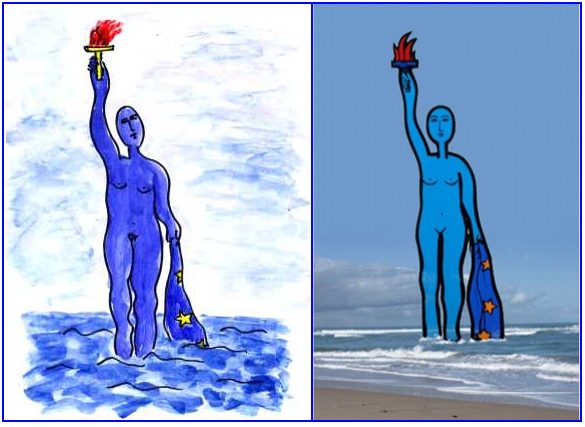
The Statue of Europe
Europe returns from America
A sign of Europe’s liberation
A symbol for the arising Europe
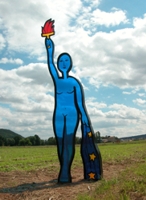
Statue of Europe No. 1
Sponsor: RST Stahlbau
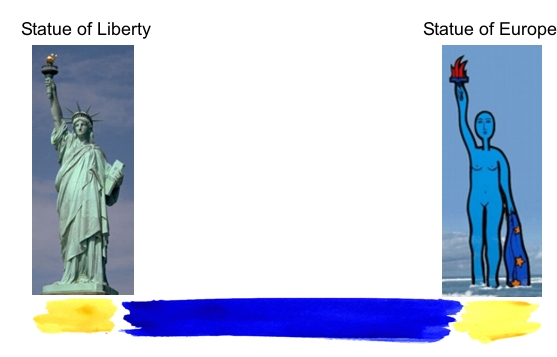
America was discovered and colonized
by Europeans. Language, culture, religion, economy – the complete
social system origins from European structures. Even the name derives
from the Italian navigator Amerigo Vespucci. European emigrates
established a kind of „United States of Europe“ on the
American continent. Europe found its fulfillment in the “New
World” whereas the comity of nations on the „Old Continent“
tore itself apart in countless wars.
Following the landing of the allied forces in the Normandy, Western Europe was liberated, the European Union was founded. And after the fall of the Berlin wall the Euro Currency was introduced and the Eastern enlargement took place.
Now Europe returned to the European continent with the idea to found the “United States of Europe”:
today already partly reality but still plenty of vision.
On the occasion of the 100th anniversary
of the declaration of independence, France donated the statue of
liberty to America. Today Europe is in the process of creating a
common constitution.
The Statue of Europe symbolizes this newly created Europe and the
victory of freedom in Europe. The base is the common cultural identity.
Jean Monnet, initiator of the Coal and Steel Union (the foundation
of the European Community), once said: If he could re-start the
creation of Europe he’d begin with the culture. Europe needs
an a portray of its identity, its common origin.
The 46 meters high Statue of Europe enters
the European continent on the Atlantic coast and symbolizes: Europe
- the soul of the statue of liberty - moved from its plinth in New
York and returned from America. Now she is wandering over the old
continent: from France via Brussels (the political center of Europe),
Germany, Italy, … to Poland, Hungary…, and with relevance
to the present, up to the Ukraine. A portray of the soul of the
new Europe.
Statue of
Europe :
Height:
151 ft (as high as the statue of liberty)
Construction:
Steel-Glass-construction: a frame of steel forms the outer shape
of a bare female figure, the figure itself consist of perspex (
i.e. Macrolon – extremely resistant).
Figure/ Color:
A magnificent female figure, modeled according to a classical Greek
statue, walking forth. Arising from the sea, she walks towards the
land.
The woman’s body is colored blue (blue glass); The outer shape
(face, hands,...) is colored
black. To increase the sculptural effect maybe shadings will be
applied (half-tone dots: Andy Warhol/ Roy Lichtenstein).
The steel frame is colored black.
Right Hand:
Holds a torch with the flame of freedom (if possible a real flame).
Torch: colored gold
Left Hand:
Holds a blue cloth (dark blue) with 3 golden stars (this might be
a dress or the
European flag – this aspect remains unanswered).
The golden torch and the golden stars refer to each other in regards
to space and content: looking at the torch with the flame of freedom,
everybody adds in thoughts some more stars.
Base:
The base is hidden under sand (the statue has no plinth):
- at low tide the Statue of Europe walks on the beach
- during tide the water stands up to her knees.
2 Views:
Front View:
from the country side
Back View:
from the sea side (this side is equal to the front view but a mirror
view)
The sculpture has two different front views: she walks into both
directions.
Sloping view: interesting distortions and overlapping will arise
(photos of the model)
During Day:
The glass sculpture casts a blue shadow.
Nachts:
Illumination of the glass surface.
Only the blue female figure can be seen, the black steel construction
is hidden in the darkness.
The Statue of Europe rises mystically from the sea (Venus, die Schaumgeborene).
Examples:
- Statues of liberty and their examples:
- The Colossos of Rhodes (Memorial of a successful resistance to
a siege)
- Eugène Delacroix „Liberty leads the nation“;
Louvre (Background: Revolution in 1830; Model: Jeanne d‘Arc)
- „Nike from Samothrake“; Louvre; Origin: Rhodes. (The
goddess stands on the bow of a ship, leading it through a storm
to victory)
- „Venus from Milo“, Louvre
- Boticelli: „Birth of Venus“
- Yves Klein: Venus, Anthropometrie
- Le Corbusier „the Modulor“
- Picasso: „Blue Phase“
- Matisse: „Blue nude IV“
.....
- up to “the Taurus of Lascaux” (Europe’s origin)
Europa is portrayed without the Taurus.
Europa is not a girl anymore, kidnapped and seduced by a Taurus,
she is now an adult, self-confident woman.
The identification of the statue is ensured by the blue colour and
the blue cloth with the golden stars. The statue does not need a
corona because she, herself, is a shining figure in two respects:
1. through the used material: transparent glass
2. through the color blue:
- During the mediaeval mysticism blue was not meant to be a color
but represented quite simply the light (Fra Angelico).
- When it came to decide for a flag and a color to represent the
European Community, the Europeans
decided of their favourite colour blue. This affectation is bound
to their culture (Japanese for example prefer white.)
Site/Location:
In France, on the beach of the Normandy, where the landing of the
allied forces took place.
Respectively on the beach of the Bretagne near Brest, the most western
part of the European continent.
Further Sites/Location:
Europe enters the European continent on the Atlantic coast and wanders
through Europe.
Further locations for the Statue, whereas the size of the statue
is adjusted to the local conditions, are:
- in Brussels
- in Spain, Italy, ....
- on the former border between the Federal Republic of Germany and
the former German Democratic Republic (fall of the wall)
- on the border of Germany and Poland, ... Hungary, ...Rumania,
... up to Ukraine (Liberty and democracy for the countries of the
former Eastern bloc)
Variations:
Variations of the Europe statue are planned – where appropriate,
in a blue dress respectively with a Taurus i.e. on Crete or as a
female torero in Spain.
Expenses/Costs:
Still to be determined – but reasonably priced because of
the simple construction principle
Financing:
- private contributions
- no public money
- selling of drawings and paintings (Christo’s principle)
- Merchandising
Note:
Already during World War I, in the dugouts of Verdun, the soldiers
longed for Europa as protective goddess, making war between the
European nations impossible.
The Statue of Europe strides self-confident towards the future and
stands for the idea of freedom and humanity.
Coming from the „New World“, she symbolizes the “New
Europe”. But still she proudly carries the “Old World”,
the “Old Europe” within herself.
For sure such a Statue becomes a Tourist Attraction and conveys
especially for the younger generation the European idea.
Initiator:
Herbert Fell (Artist and Engineer)
The Statue of Europe
Blue glass sculpture with black steel construction: 151 ft high
Photomontage:
In the manner of the American Statue of Liberty the Statue of Europe
enters the European continent on the Atlantic coast:
Europe returns
to the European Continent.
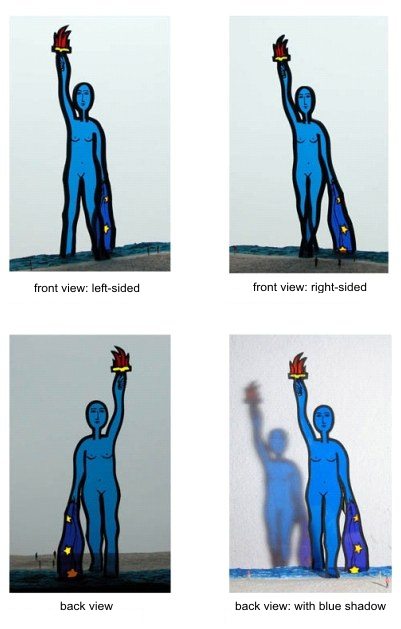
Example for demonstration:
glass sculpture „Barbarossa“
The sculpture „Barbarossa“
clarifies the construction principle. The Statue of Europe will
be constructed accordingly.
Construction principle: glass – steel construction: the steel
construction forms the shape of the figure.
Height of the Barbarossa Sculpture: 20 ft
The stability is ensured by the heavy outer frame. The depth of
the frame is 8 in. The glass surfaces consist of Macrolon, 0,8 in
thick (this material is extremely resilient).
The sculpture “walks” on the ground – the foundation
is hidden beneath.
The drawing (black) is applied on both sides of the glass surface.
The transparency of the glass gives the compact/ consolidated figure
a lightness
(the background is visible through the figure): a striding
shining figure
There are two equal views:
front view and back view
The sculpture casts a colorful shadow
(This sculpture is not illuminated at night)

The watch tower of the former border fortification between the Federal
Republic of Germany and the former German Democratic Republic is
visible in the background.
Statue of Europe
Besides the Statue of Liberty and the
Colossos of Rhodes further Examples and associations
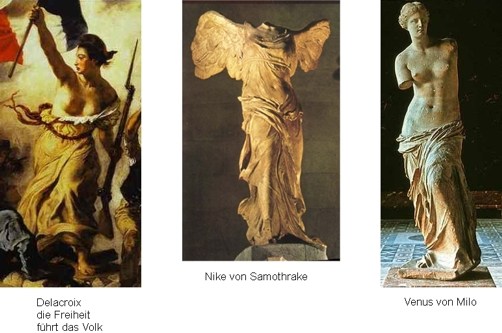
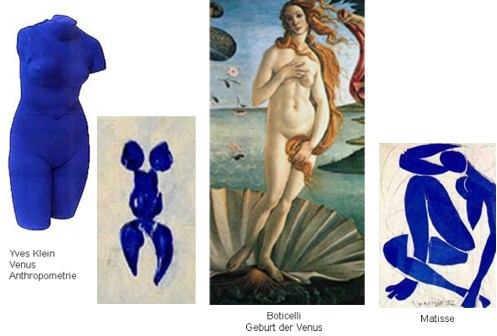

|







